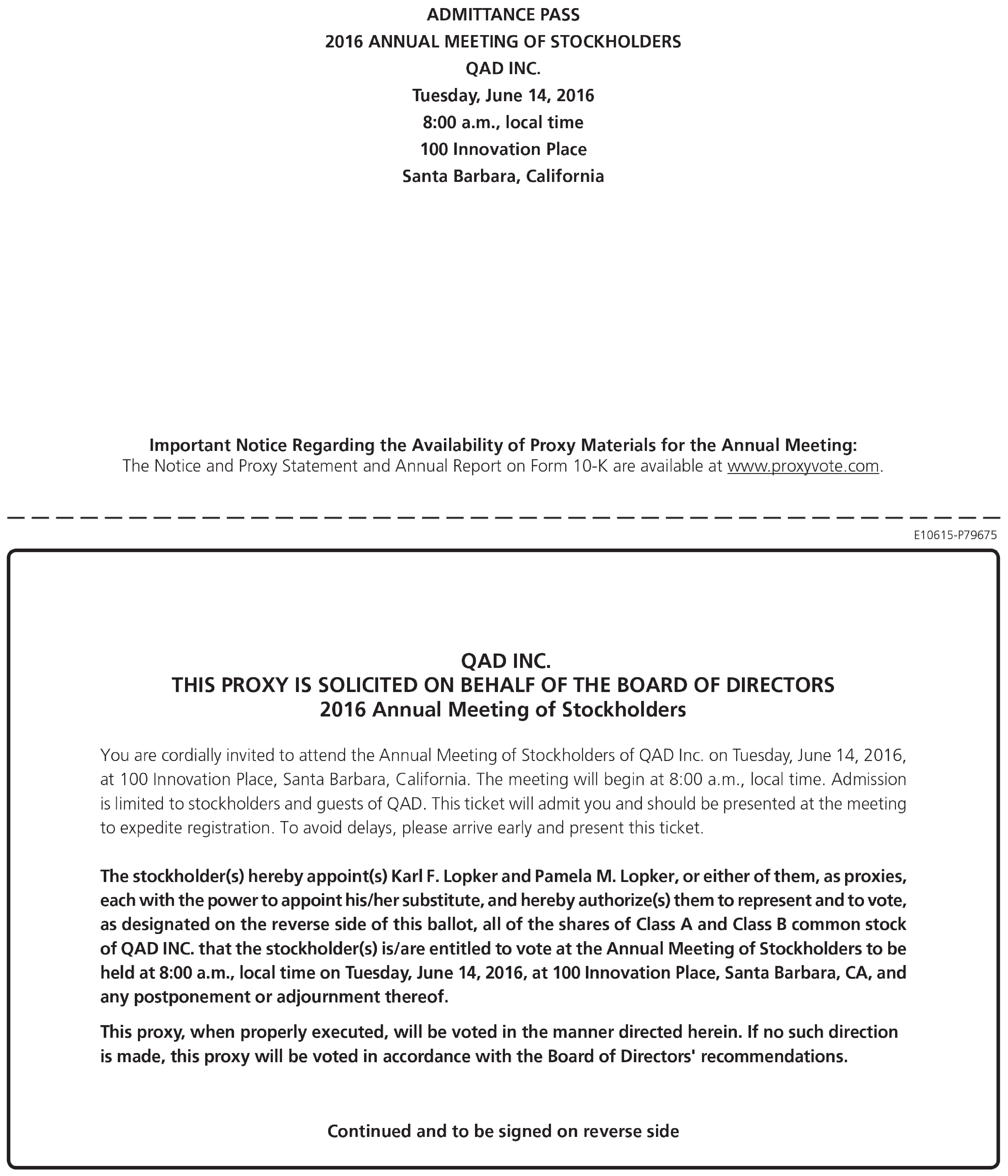Exhibit A
QAD INC.
2016 STOCK INCENTIVE PROGRAM
as adopted by Board action on April 12, 2016 (with Stockholder approval on June 14, 2016)
INTRODUCTION
The Company’s Board of Directors has adopted the QAD Inc. 2016 Stock Incentive Program effective as of July 1, 2016, upon receipt of approval by the Company’s stockholders.
1. Purpose. This 2016 Stock Incentive Program (the “Program”) is intended to secure for QAD Inc. (the “Company”), its subsidiaries, and its stockholders the benefits arising from ownership of the Company’s common stock (the “Common Stock”) by those selected individuals of the Company and its subsidiaries, who will be responsible for the future growth of such corporations. The Program is designed to help attract and retain superior personnel for positions of substantial responsibility with the Company and its subsidiaries, and to provide individuals with an additional incentive to contribute to the success of the corporations. Nothing contained herein shall be construed to amend or terminate any existing options, whether pursuant to any existing plans or otherwise granted by the Company.
2. Elements of the Program. In order to maintain flexibility in the award of stock benefits, the Program is composed of five parts. The first part is the Incentive Stock Option Plan (the “Incentive Plan”) under which are granted incentive stock options (the “Incentive Options”). The second part is the Nonqualified Stock Option Plan (the “Nonqualified Plan”) under which are granted nonqualified stock options (the “Nonqualified Options”). The third part is the Restricted Share Plan (the “Restricted Plan”) under which are granted restricted shares of Common Stock. The fourth part is the Stock Appreciation Rights Plan (the “SAR Plan”) under which stock appreciation rights (as defined therein) are granted. The fifth part is the Other Stock Rights Plan (the “OtherStock Rights Plan”) under which (i) units representing the equivalent of shares of Common Stock (the “Performance Shares”) are granted; (ii) units representing the equivalent of restricted shares of Common Stock (the “Restricted Stock Units”) are granted; (iii) payments of compensation in the form of shares of Common Stock (the “Stock Payments”) are granted; and (iv) rights to receive cash or shares of Common Stock based on the value of dividends paid with respect to a share of Common Stock (the “Dividend Equivalent Rights”) are granted. The Incentive Plan, the Nonqualified Plan, the Restricted Plan, the SAR Plan and the Other Stock Rights Plan are included herein as Part I, Part II, Part III, Part IV, and Part V, respectively, and are collectively referred to herein as the “Plans.” The grant of an option, stock appreciation right or restricted share or rights to purchase shares under one of the Plans shall not be construed to prohibit the grant of an option, stock appreciation right or restricted share or rights to purchase shares under any of the other Plans.
3. Applicability of General Provisions. Unless any Plan specifically indicates to the contrary, all Plans shall be subject to the General Provisions of the QAD Inc. 2016 Stock Incentive Program set forth below.
4. Administration of the Plans. The Plans shall be administered, construed, governed, and amended in accordance with their respective terms.
5. General Provisions of Stock Incentive Program.
Article 1. Administration. The Program shall be administered by the Company’s Board of Directors (the “Board”). If an award is to be made to an “Executive Officer” as defined in the Exchange Act as hereinafter defined, it must be approved by Program Administrators composed solely of two or more directors who are “Non-Employee Directors” within the meaning of Rule 16b-3 promulgated pursuant to the Securities Exchange Act of 1934, as amended (the “Exchange Act”), who will also be “outside directors” for purposes of Section 162(m) of the Internal Revenue Code of 1986, as amended (the “Code”). To the extent permitted under the Exchange Act, the Code or any other applicable law, the Board or the Program Administrators shall have the authority to delegate any and all power and authority to administer and operate the Program hereunder to such person or persons as the Board or the Program Administrators deems appropriate. Subject to the foregoing limitations, as applicable, the Board may from time to time remove members as Program Administrators, fill all vacancies, however caused, and may select one of the members as the Chairman of the Program Administrators. The members of the Board, the Program Administrators or such other persons appointed to administer the Program, when acting to administer the Program, are herein collectively referred to as the “Program Administrators.”
Use the Internet to transmit your voting instructions and for electronic delivery of information up until 11:59 P.M. Eastern Time the day before the cut-off date or meeting date. Have your proxy card in hand when you access the web site and follow the instructions to obtain your records and to create an electronic voting instruction form. | ||
———————————————————————————————————
 | |||||||||
A-1

